MXA RACE TEST: EVERYTHING YOU NEED TO KNOW ABOUT THE 2016 KTM 125SX
Q: FIRST AND FOREMOST, IS THE 2016 KTM 125SX BETTER THAN THE 2015 KTM 125SX?
A: For 2016, KTM threw everything that its engineers didn’t like about the 2015 KTM 125SX out the window. Then, the KTM engineers started over from the ground up with a totally new 125cc two-stroke. It should be noted that new two-strokes don’t come along very often (it has been 10 years since Yamaha re-engineered the Y1Z25), so this is big news.
Q: HOW MUCH DOES A 2016 KTM 125SX COST?
A: The 125SX is KTM’s most affordable full-size bike. The 125SX retails for $6799; the 150SX for $6899; the 250SX for $7399; the 250SXF for $8399; the 350SXF for $9099; and the 450SXF for $9299.
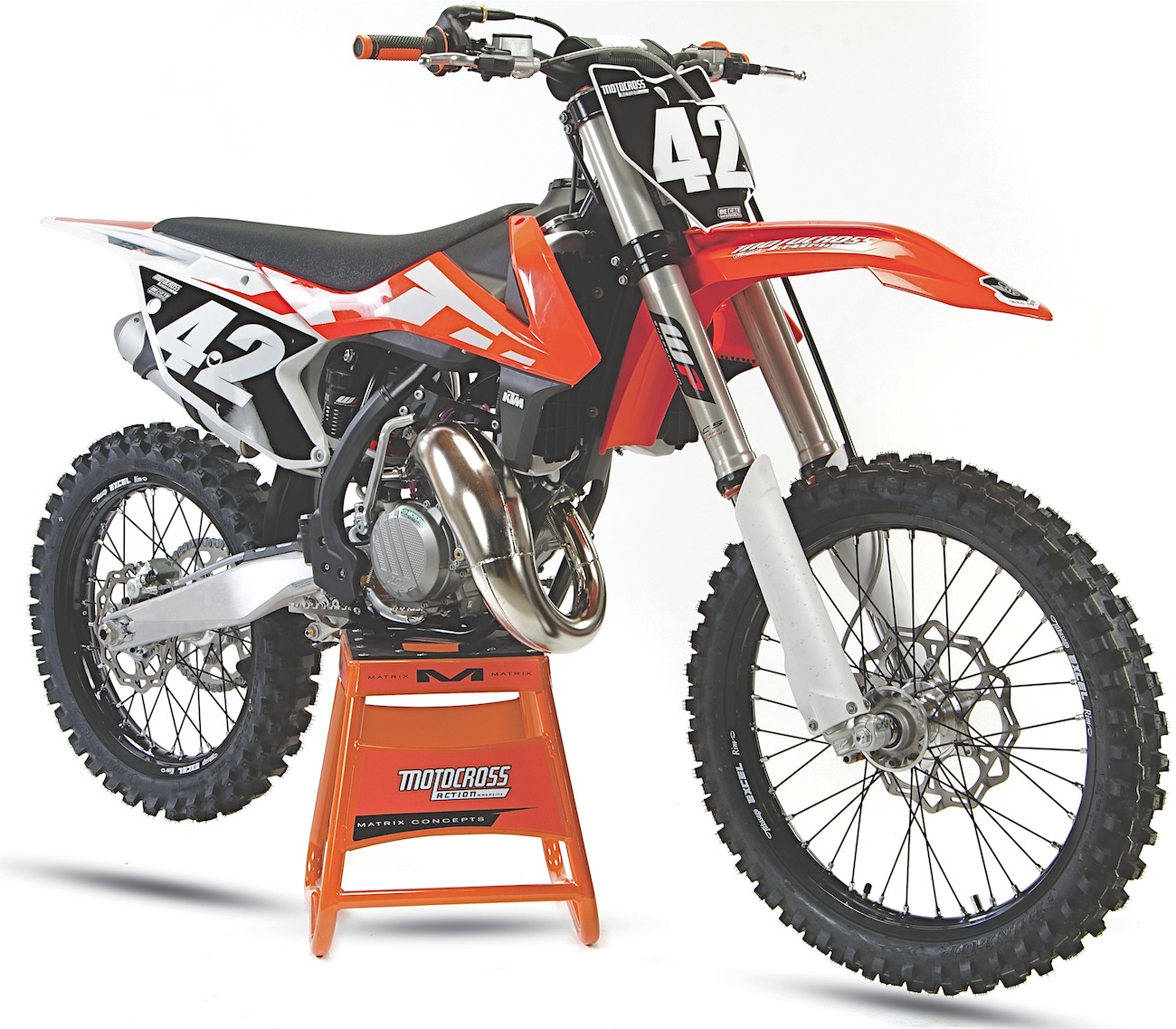 Q: WHAT CHANGES DID KTM MAKE TO THE 2016 125SX CHASSIS?
Q: WHAT CHANGES DID KTM MAKE TO THE 2016 125SX CHASSIS?
A: KTM’s brass made the expensive decision to not just update one or two models, but to throw out the complete playbook, save for the 250SX, and start over with the development of the 2016 450SXF, 350SXF, 250SXF, 150SX and 125SX. Given the incremental R&D at some Japanese brands, KTM’s full-on assault is knock-your-socks-off brave. To build five totally new machines with new engines, frames, running gear, bodywork and internals is expensive. Even with parts-sharing, this isn’t cheap. Luckily, KTM can use the basic bones of the core machine on all five bikes, but you can’t use a 450 four-stroke frame for a 125 two-stroke. Why not? The tiny 125 engine would be floating in the larger compartment of the four-stroke-specific chassis and, instead of a 198-pound 125, you’d have a two-stroke that was 10 to 15 pounds heavier. KTM didn’t want that, so it made updates to the KTM 125SX that were quite different from the ones made to its big brothers. Here is a list of chassis updates that differ from the 2015 125SX.
(1) Frame. The chromoly steel frame has been lightened (0.8 pounds) and provides 20 percent more torsional rigidity and 30 percent less longitudinal stiffness.
(2) Geometry. The wheelbase has been shortened by 10mm and the head angle steepened by 0.4mm.
(3) Paint. Why mention paint? It’s not a big deal, right? Well, we got our feelings hurt when KTM went from awesome orange to a basic black frame.
(4) Subframe. The aluminum subframe is smaller and 20 percent lighter.
(5) Swingarm. To the naked eye, the 2016 swingarm looks the same as the 2015 model’s, but the internal structure has been revised to match the flex characteristics. It is also lighter.
(6) Footpegs. The all-new, larger, more stable footpegs are a work of art. They utilize a scraper design to reduce dirt buildup in the hinge, which keeps them working correctly.
(7) Triple clamps. The CNC-machined triple clamp offset remains at 22mm, but the handlebars are now rubber-mounted to reduce vibration at the handlebars. The top clamp has the ability to adjust the bars forward and backward.
(8) Airbox. The no-tools airbox has been updated to be even simpler, and the filter is the first-ever plug-and-play design. Every bike should have one.
(9) Fork settings. The quick-adjust WP 4CS fork settings have been updated and use softer fork springs—from 4.4 N/m to 4.2 N/m.
 2016 KTM 125SX: At 198 pounds the KTM 125SX is light as a feather. Thanks to its awesome brakes, clean design and impressive horsepower the 125SX is fun personified.
2016 KTM 125SX: At 198 pounds the KTM 125SX is light as a feather. Thanks to its awesome brakes, clean design and impressive horsepower the 125SX is fun personified.
(10) Shock. The 125SX gets the latest-generation WP shock. It features a revised reservoir, new piston, new shock shaft and new clevis design that shortens the shock length by 12mm. The linkage is also an all-new design to fit the architecture of the new frame.
Q: WHAT CHANGES DID KTM MAKE TO THE 125SX ENGINE?
A: The goals for KTM in developing the 2016 125SX engine were to reduce weight, scale it down and improve performance. Virtually nothing is interchangeable with the 2015 model. The major changes are as follows:
(1) The clutch shaft is 27mm higher and the crankshaft was raised by 37mm in order to make the engine more compact.
(2) The overall engine weight is an amazing 4 pounds lighter.
(3) We doubt that an electric starter is in the 125SX’s immediate future, but the engine cases have been designed for the possibility. We can’t wait until that day comes.
(4) The laundry list of additional changes includes a new cylinder, piston, two-piece head, crankshaft, six-speed transmission and redesigned power valve.
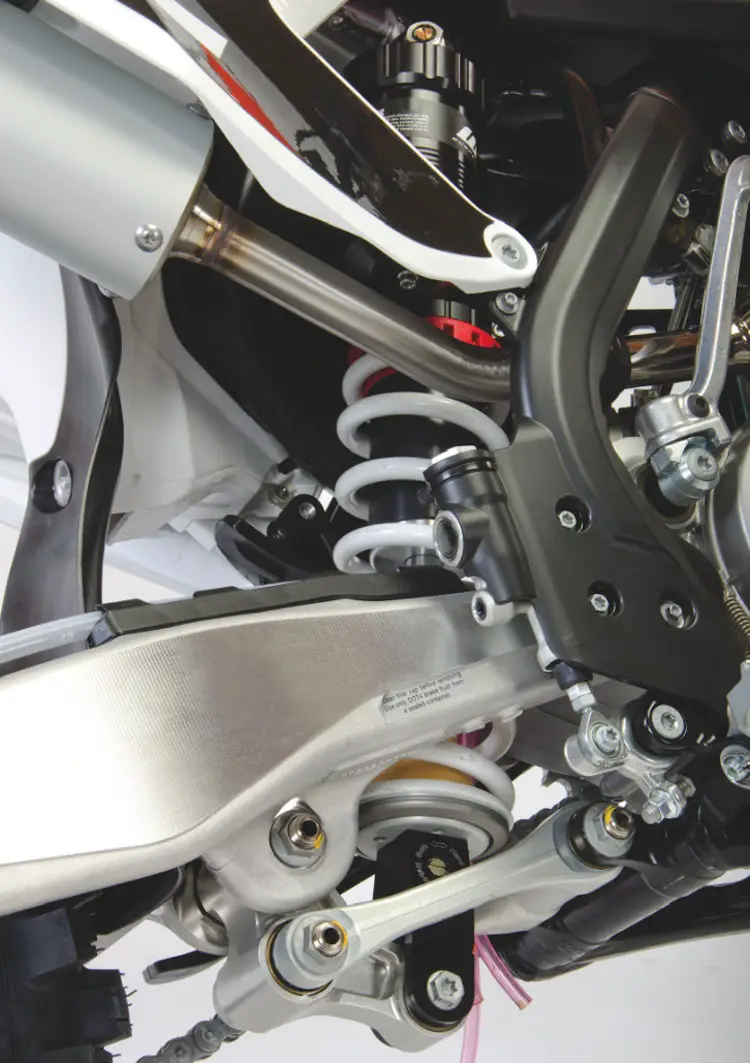 Stiff upper lip: Unlike the KTM 350SXF and 450SXF, the KTM 125SX has the perfect shock spring rate.
Stiff upper lip: Unlike the KTM 350SXF and 450SXF, the KTM 125SX has the perfect shock spring rate.
Q: WHAT ELSE IS NEW ON THE 2016 KTM 125SX TWO-STROKE?
A: The following upgrades were made not only to the 125SX but also to the 450SXF, 350SXF, 250SXF and 150SX. They are brand-specific changes rather than model-specific.
(1) Bodywork. All the bodywork—from head to tail—is totally new. The front number plate incorporates the front brake-hose holder. The seat is lower and flatter. KTM’s engineers even added an embossed sag-line indicator on the rear fender to help riders get accurate sag measurements. The bodywork was designed for performance, not just appeal.
(2) Radiators. The WP-built radiators are redesigned to be more efficient, allowing for better air flow and lower temperatures. The radiator guards don’t just knock down roost but also provide structural rigidity to the radiator. No need for aftermarket radiator braces.
(3) Brakes. The Galfer Wave rotors have been updated with lighter rotors. The modulation characteristics of the brakes seem to be mellower, but that’s okay because they are still best-in-class.
(4) Tires. KTM must have read our test on the Geomax MX32s in comparison to last year’s Geomax MX52s. The KTM line is the only brand to come stock with premium intermediate-terrain race tires.
Q: WHAT ARE THE DIFFERENCES BETWEEN A 125SX AND A 150SX?
A: To the naked eye, the KTM 125SX and 150SX look identical. They share the same suspension, frame, shock linkages, brakes, wheels and engine architecture, but they aren’t identical twins. Here are the six major differences.
(1) Displacement. The 125SX has a 124.8cc displacement, while the 150SX is 143.99cc.
(2) Bore and stroke. The 125SX’s bore and stroke is a classic 54mm by 54.5mm, while the 150SX has a larger 58mm bore combined with the same 54.5mm stroke. With both bikes having the same stroke, the cylinders are interchangeable. The 125SX can be made into a 150SX and vice versa.
(3) Gearing. More power can pull taller gearing, thus the 150SX comes with 13/48 gearing while the 125SX gets 13/50.
(4) Parts. The cylinder, piston, power valve, head stays, power valve governor spring and rings are different on the 125SX and 150SX.
(5) ECU. The ECU is the standard KTM unit, but the 150SX and 125SX each have unique mapping.
(6) Jetting. The 125SX has a smaller main and pilot jet, as well as a different needle.
Q: HOW FAST IS THE 2016 KTM 125SX?
A: It is no secret that 125cc two-strokes are at the bottom of the totem poll in terms of sheer power. For 2016, the KTM 125SX has closed the gap on the 250 four-stroke bottom dwellers, such as the CRF250. On the track, the 125SX has a perky powerband that is easier to ride than in previous years. This low-end grunt is a sensation that its main competitor, the YZ125, lacks. The YZ125’s short powerband is more of a light switch when compared to the high-rpm 125SX. With the YZ125, you either have the throttle off or you are feathering the clutch until it flickers on. Don’t get us wrong; last year we favored the YZ125 over the KTM 125SX, but there is only so much horsepower a decade-old bike can give up before it isn’t in the running anymore. The KTM 125SX is very fast for a 125cc machine.
Q: HOW DOES THE 2016 KTM 125SX RUN ON THE DYNO?
A: The 2016 KTM 125SX makes a whopping 37.27 horsepower and 17.35 foot-pounds of torque on the dyno. That is an iota below the 2015 Honda CR250F four-stroke. At peak, the 2016 KTM 125SX makes a little over 2 horsepower more than the 2015 KTM 125SX and the 2016 overpowers the 2015 by one horsepower or more from 9000 rpm to 11,000 rpm. But, whereas the 2015 KTM 125SX peaked at 11,200 rpm then sharply fell off the pipe (to a measly 27.67 horsepower at 12,000 rpm), the 2016 KTM 125SX pumps out 7 more ponies at 12,000 rpm and over 2 horsepower at peak, which is 500 rpm higher. Compared to the YZ125, the 2016 KTM 125SX produces 3 horsepower more at peak. The 2016 KTM 125SX is the best-running 125cc we have put on the dyno to date.
Q: IS THE 2016 KTM 125SX SUSPENSION BETTER THAN THE 2015 SUSPENSION?
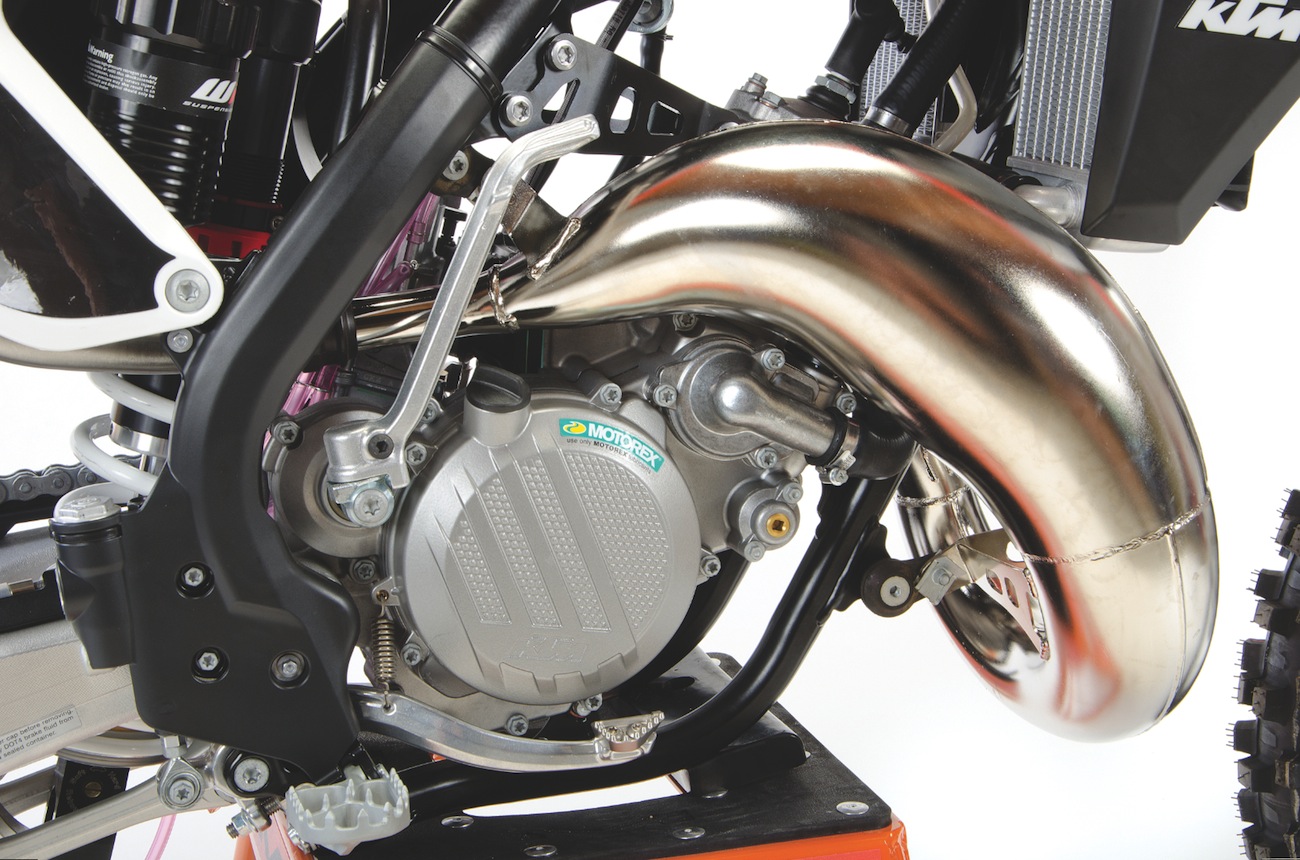 Record setter: The 2016 KTM 125SX makes a whopping 37.27 horsepower. That’s encroaching on 250 four-stroke territory.
Record setter: The 2016 KTM 125SX makes a whopping 37.27 horsepower. That’s encroaching on 250 four-stroke territory.
A: KTM’s Achilles heel is on the mend. The forks on last year’s 2015 125SX were harsh from the top of the stroke through the middle, but you couldn’t soften the clickers or the forks would blow through the stroke. It was a catch-22. For 2016, the KTM 125SX’s WP forks are plush yet progressive, with the shock following the fork characteristics to make for a balanced setup. You can’t give WP all the credit, though, because the new frame geometry aided in the pleasant overall feel of the 125SX. Oh, wait, WP also makes KTM’s frames.
We want to note that both ends of the 125SX’s suspension are exactly the same on the 2016 KTM 150SX, but they do not handle the same. Why? Blame it on the 19.19cc difference between the two. The 150SX packs a bigger punch that transfers more load to the rear end. The 150SX also falls off the pipe more suddenly, which puts more weight on the front end. The 150SX’s more aggressive powerplant makes for a less balanced chassis. We like the 125SX’s suspension better than the 150SX’s suspension—not because of the WP components, but because the 125’s smoother powerband makes the chassis more responsive.
Q: WHICH BIKE IS FASTER; THE 2016 KTM 125SX OR THE 150SX?
A: To be honest, it’s a toss-up. Everyone loved the smooth powerband of the 125SX. The 150SX was harder to manage. But, the bottom line is that the 150SX makes 3 more ponies at peak, and you can feel it, especially on the way to a big jump. The question is, would you rather have an easy-to-ride bike with a broad powerband or a quirky, fast-revving engine that will boot you over big doubles?
Q: IS THE 2016 KTM 125SX COMPETITIVE IN THE 250 FOUR-STOKE CLASS?
A: On the dyno it looks closer than it is. It is only a hair off the 2015 Honda CRF250 on peak power. Plus, the 198-pound 125SX is only 20 pounds lighter than most 250 four-strokes. If you do the math, on paper, the 37.27 horsepower 125SX should beat a 40.5 horsepower machine that weighs 220 pounds. That means it would run with a Kawasaki KX250F, Honda CRF250 and the Suzuki RM-Z250. Does it feel like that on the track? No. The nimble feel of the 125SX will allow you to make time on the 250 four-strokes on the tight parts of the track, but down straights you will lose ground. The 125SX’s Achilles heels are big hills, deep sand, hard-pack dirt and long starts. The abundant torque of the four-strokes will yank the smoker under these conditions. The 125SX would not win the race against a sea of 250 four-strokes, but the 125 rider will have more fun trying.
Q: WHAT IS THE ONE CHANGE EVERY 125SX OWNER SHOULD MAKE?
A: Gearing. As with the 150SX, we opted to gear the bike up. We went with a 49-tooth rear rather than the stock 50 because it felt like a 51. Hold on; did that make sense? The bike was lacking bottom-end grunt, so naturally we wanted to go bigger on the rear sprocket, but this shortened the powerband, requiring more shifting. When we went to a smaller rear sprocket, the 125SX felt like it had more snap off the bottom and a broader powerband. Additionally, it made us ride a gear lower, which raised the rpm in the sections where we were lacking grunt before. Our testers, who never know what gear they’re in, were deluded into thinking we put a 51-tooth sprocket on the rear instead of a 49.
A: The hate list:
(1) Gas cap vent hose. KTM’s vent hose gets twisted in a knot when you take it on and off to fill the tank. You have to spin it in reverse before putting it back on.
(2) Sprocket bolts. Watch them like a hawk, as they come loose quickly.Additionally, always check the rear spokes for tightness. If the spokes next to the rim lock are loose, you should break out the spoke wrench immediately.
(3) Gearing. We found a perkier, easier-to-ride powerband by going taller on the gearing.
(4) Grips. All the 2016 four-stroke KTM SXF models got upgraded to ODI lock-on grips. And guess what? We love them. Sadly, the KTM 125SX has last year’s orange and black grips. We don’t love them.
(5) Black frame. We don’t hate the black frame color; we just hate that KTM changed it from orange to black.
(6) Shift lever. We broke two shift lever springs, but only on KTM’s two stroke models and never after the first two failures. KTM told us early on that they had an updated shift tip spring in the works, so they must have installed it.
(7) Tires. Although we don’t really hate the Dunlop MX32 front tire, we do need to warn riders that if they push the MX32s across hard-terrain dirt, they need to keep a close eye on the side knobs. They will tear off.
 This is the wrong way for the brake pedal spring to be installed.
This is the wrong way for the brake pedal spring to be installed.
(8) Brake pedal spring. We turn the brake pedals spring around so that the tang at the brake peal is tucked in. If the tang sticks out your boot can knock it off. We know from experience.
(9) Foot peg springs. The 2016 foot peg sprinsg mount in a different manner than the previous KTM foot peg springs. Many dealers are still installing the springs the old way. If they do they will break.
(10) Gas cap. The gas cap sticks. Take a karate class.
(11) Crossbar pad. It may sound picky, but we don’t like how the crossbar pad shifts back and forth on the handlebars.
(12) Fork clickers. Although you love the ability to change the compression and rebound settings on the WP forks without having to dig in the toolbox for a screwdriver, the cog-shaped clicker needs to have longer cogs so that the clicks can be made much quicker and easier.
(13) Shock collar. Be very kind to the plastic shock collar. It doesn’t take much abuse before it’s rendered incapable of adjustment. We lube the threads after washing the bike and always pry the preload ring with a long screwdriver rather than hitting it with a punch.
(14) Front spokes. KTM has a recall for the front spokes on some models. Call your local dealer or go to the KTM website and check in the “service” section to see if your VIN number is affected.
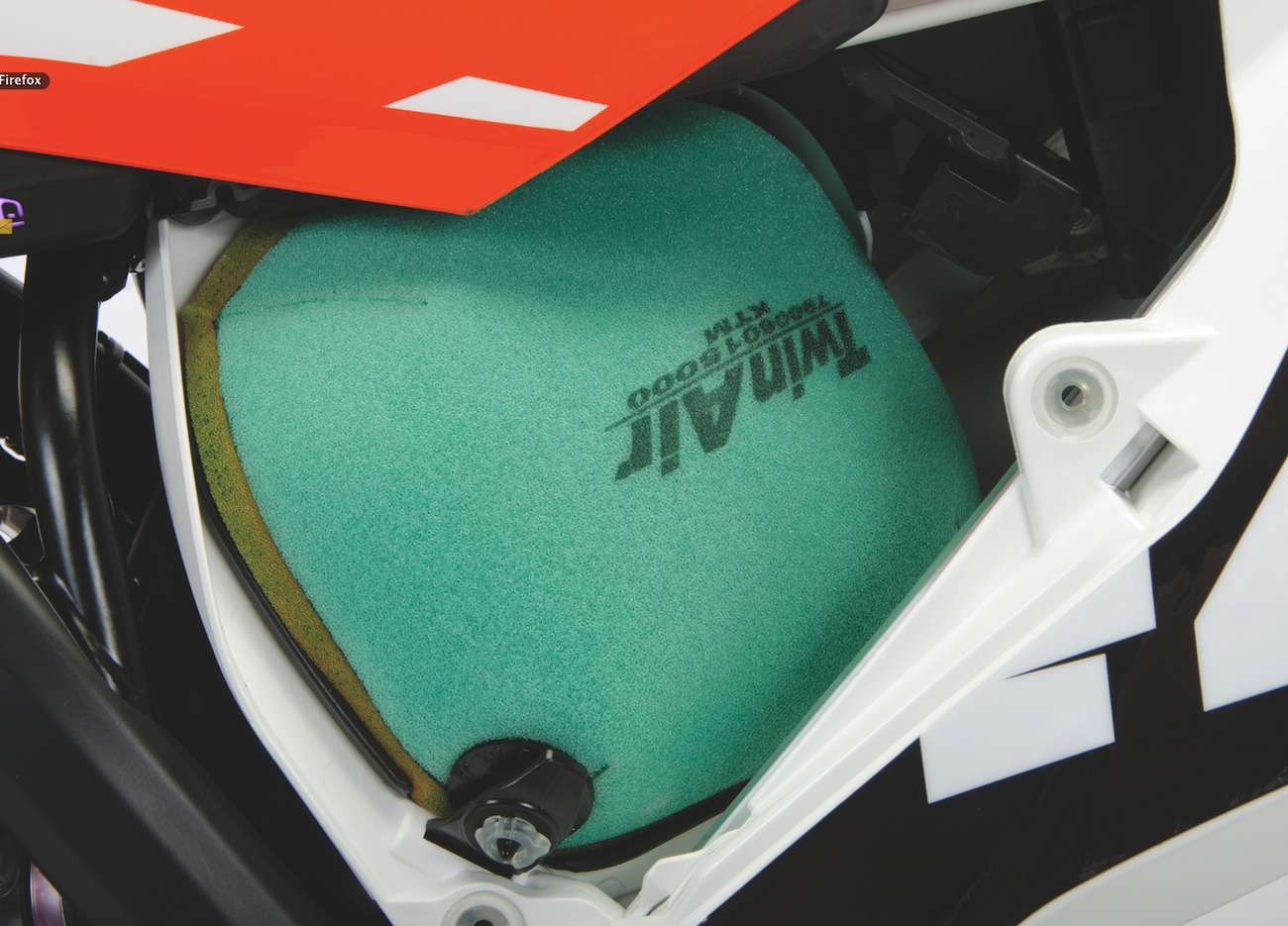 Forgiving. You can even put the air filter in upside down.
Forgiving. You can even put the air filter in upside down.
Q: WHAT DID WE LIKE?
A: The like list:
(1) Weight. The 2016 KTM 125SX is 8-1/2 pounds lighter than the 2015 model and 20 pounds lighter than the lightest 250 four-stroke.
(2) Brakes. They are not as strong as last year’s, but they are still the best in the class.
(3) Hydraulic clutch. KTM’s self-adjusting clutch is ahead of its time.
(4) Airbox. We don’t think changing an air filter could get any simpler.
(5) Sag line. It helps you adjust the sag with ease.
(6) Easy-adjust forks. We love that you can pull off the side of the track and adjust the forks without tools.
(7) Suspension. These are not SSS components, but they are a big step in the right direction.
(8) Fuel. Our 2016 KTM 125SX ran well on 91-octane pump gas, but we always added a dash of VP Racing C12 as a precaution.
(9) Tires. The 125SX comes with our favorite tires—Dunlop Geomax MX32s.
Q: WHAT DO WE REALLY THINK?
A: The Japanese manufacturers need to step up to the plate and start producing two-strokes again. The 125cc has always been the stepping stone bike for riders coming off of 85cc machines and the entry point for neophyte riders. Without a vibrant 125cc class, the sport is going to have trouble filling the newbie ranks. With that said, the 2016 KTM 125SX is superior to the 2015 model. We loved every second of riding this machine. The powerband is incredible and the WP suspension is surprisingly good. There is not much to complain about.
MXA’S KTM 125SX SETUP SPECS
This is how we set up our 2016 KTM 125SX for racing. We offer it as a guide to help you find your own sweet spot.
WP FORK SETTINGS
It was easy to find a happy medium for just about any size rider with the updated WP 4CS forks. We had riders from 135 pounds to over 200 pounds who found a setting that worked for them. Raising the forks in the clamps 4mm above the second line improved cornering and provided a more balanced feel. The spring rate is softer than last year’s, going from 4.4 N/m to 4.2 N/m. The following settings are what worked best for a 170-pound Novice. For heavier or lighter riders, we adjusted the compression accordingly and left the rebound alone. Here is what we ran (stock settings are in parentheses):
Spring rate: 4.2 N/m
Compression: 8 clicks out (15 clicks out)
Rebound: 12 clicks out (15 clicks out)
Fork-leg height: 9mm up (5mm)
Notes: The fork spring rate is light because of the target weight of the typical 125/150 rider. If you are heavier, don’t worry, the WP suspension has enough adjustment to accommodate you. Lighter riders can turn the compression clicker out to get the feel they want.
WP SHOCK SETTINGS
KTM’s overall plan with the chassis, along with the updated WP shock and rising-rate linkage, was to soften the shock spring rates considerably (going lighter helps the KTM). For hard-core racing, we recommend this shock setup for the 2016 KTM 125SX (stock specs are in parentheses):
Spring rate: 42 N/mm
Race sag: 102mm
Hi-compression: 2 turns out
Lo-compression: 10 out (15 out)
Rebound: 11 out (15 out)
Notes: We run less race sag than KTM’s recommended 110mm. We feel the bike rides too low and sacrifices cornering at 110mm, so we raise the sag and lower the forks for better balance and improved cornering.
KEIHIN PWK 38S JETTING SPECS
Here’s what we ran in our 38mm PWK (stock settings are in parentheses).
Main jet: 182
Pilot: 50
Needle: NIEF needle
Clip: 2nd clip from top
Air screw: 2 turns out (1 turn)



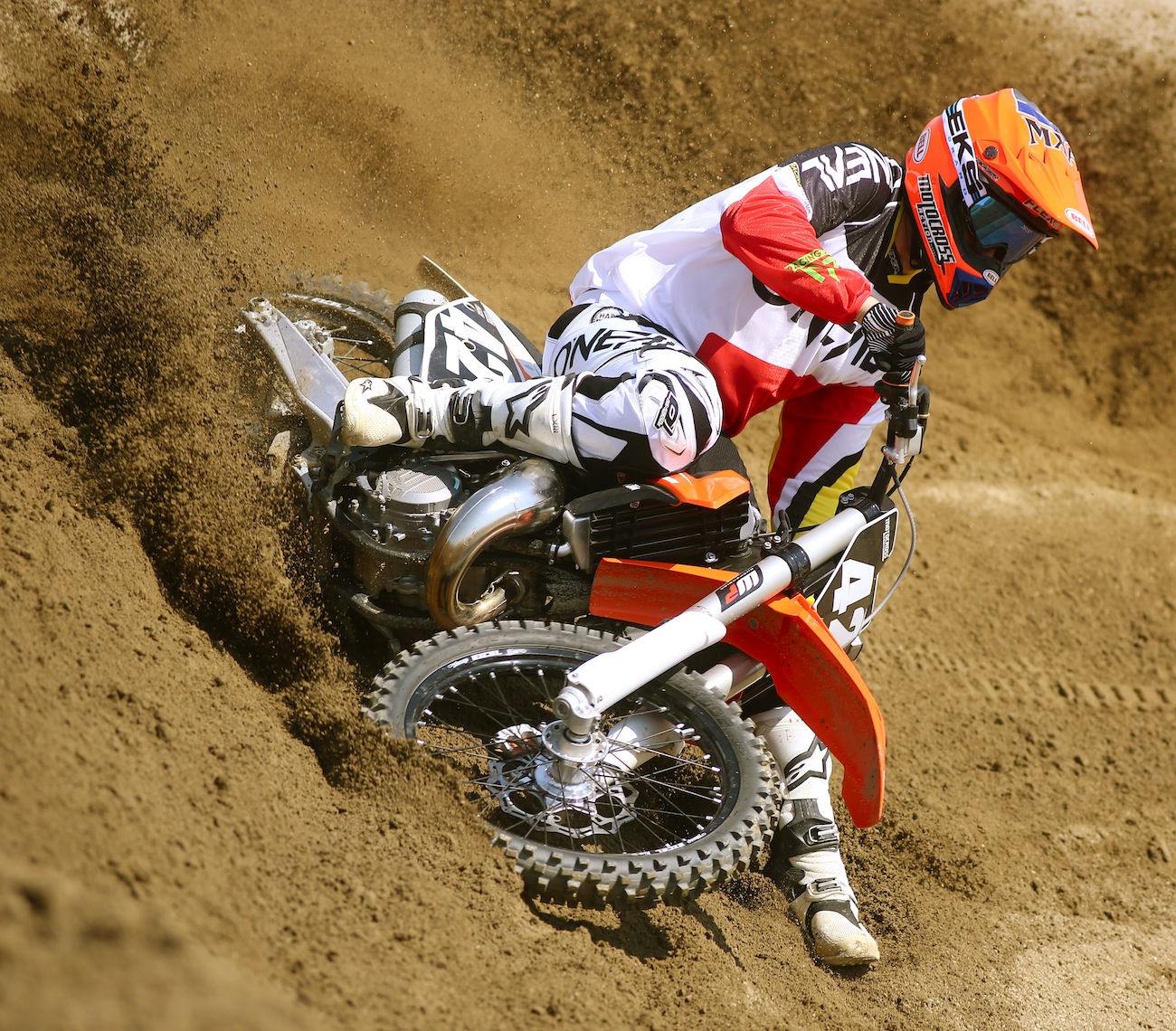
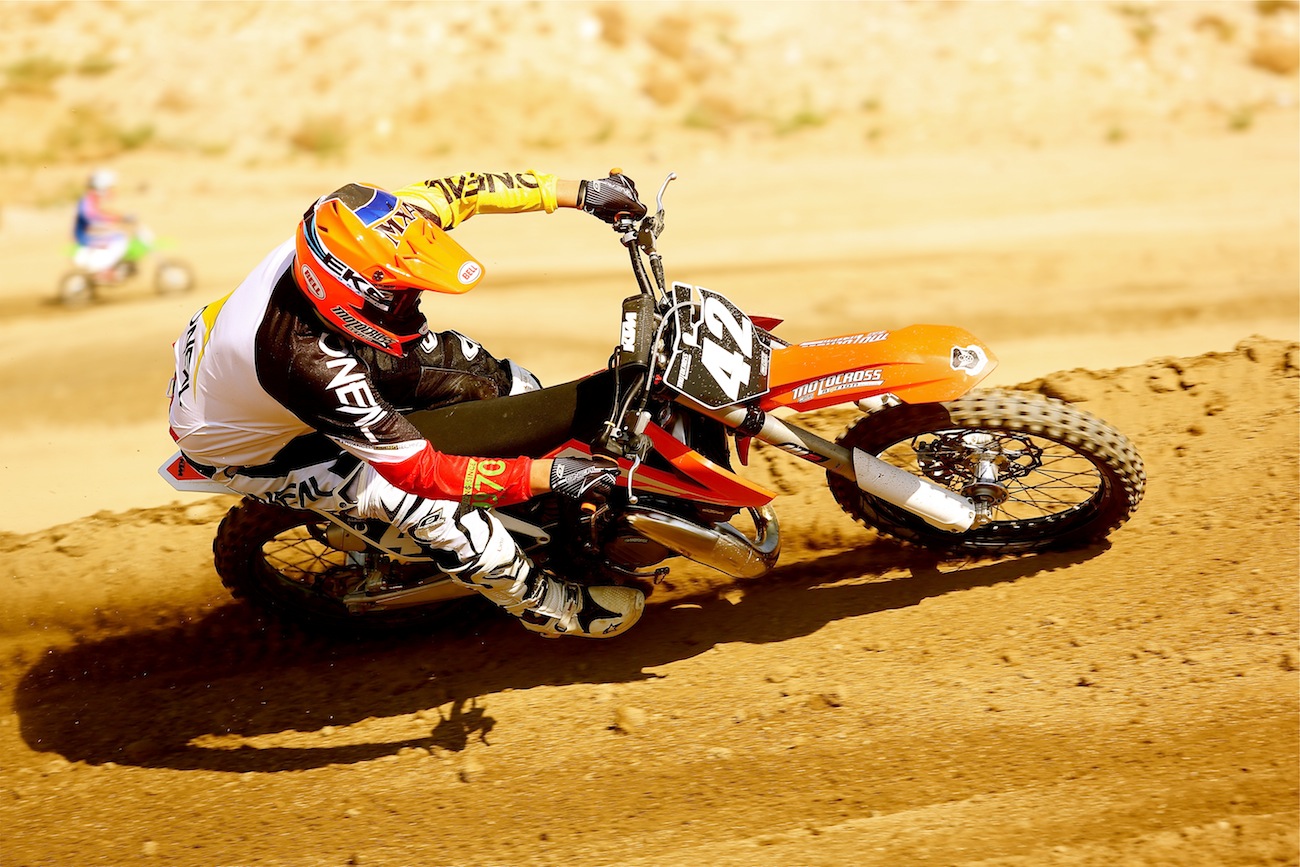


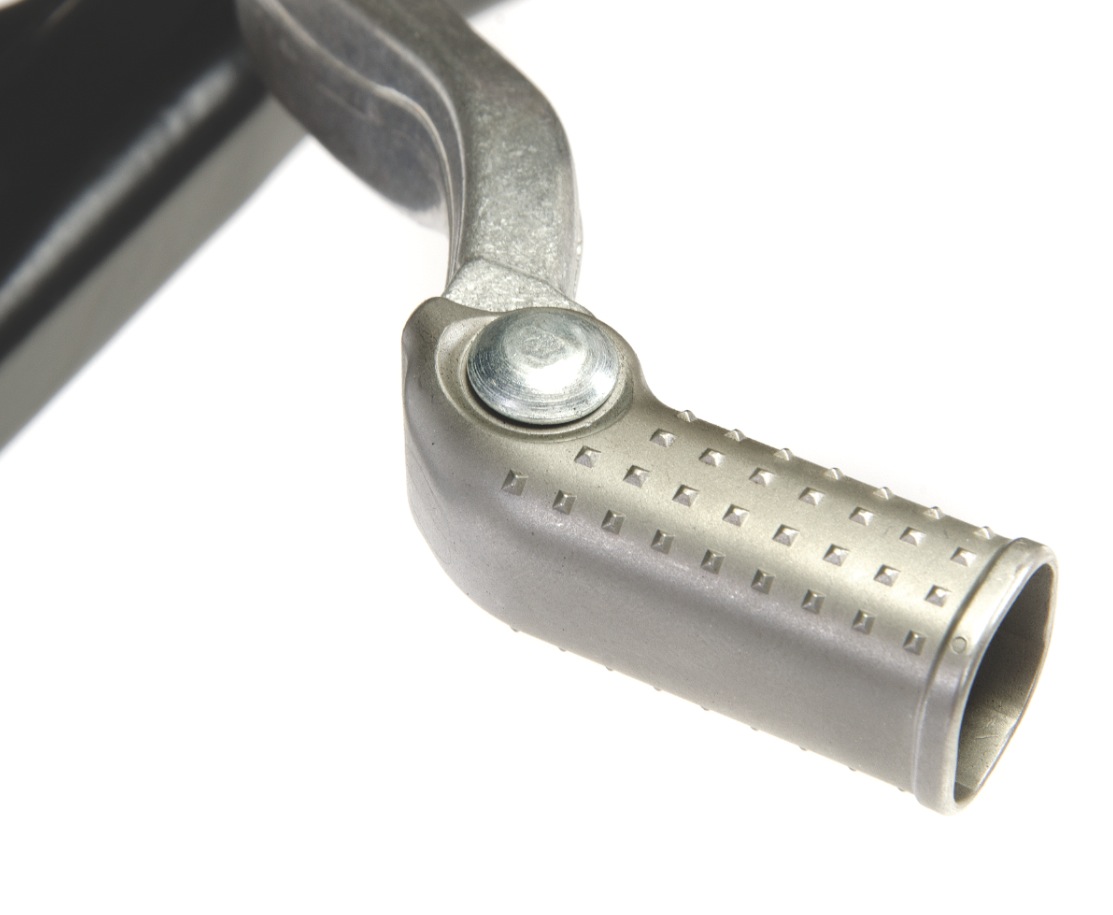
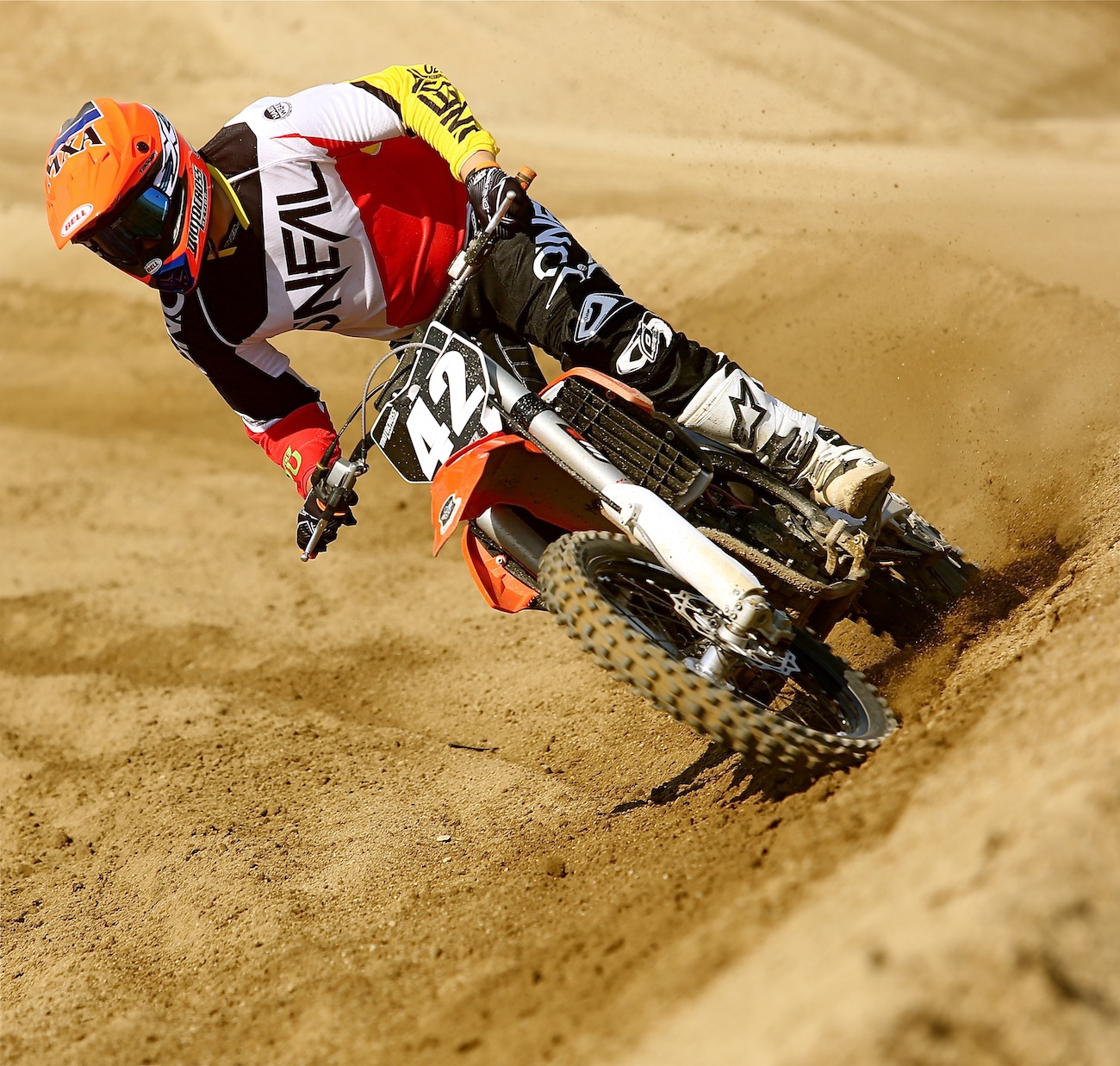





Comments are closed.